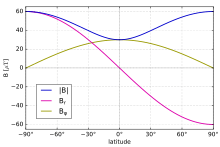Dipole model of the Earth's magnetic field
The dipole model of the Earth's magnetic field is a first order approximation of the rather complex true Earth's magnetic field. Due to effects of the interplanetary magnetic field (IMF), and the solar wind, the dipole model is particularly inaccurate at high L-shells (e.g., above L=3), but may be a good approximation for lower L-shells. For more precise work, or for any work at higher L-shells, a more accurate model that incorporates solar effects, such as the Tsyganenko magnetic field model, is recommended.

Equations
The following equations describe the dipole magnetic field.[1]
First, define as the mean value of the magnetic field at the magnetic equator on the Earth's surface. Typically .
Then, the radial and azimuthal fields can be described as
where is the mean radius of the Earth (approximately 6370 km), is the radial distance from the center of the Earth (using the same units as used for ), and is the azimuth measured from the north magnetic pole (or geomagnetic pole).

It is sometimes more convenient to express the magnetic field in terms of magnetic latitude and distance in Earth radii. The magnetic latitude (MLAT), or geomagnetic latitude, is measured northwards from the equator (analogous to geographic latitude) and is related to by . In this case, the radial and azimuthal components of the magnetic field (the latter still in the direction, measured from the axis of the north pole) are given by
where in this case has units of Earth radii ().
Invariant latitude
Invariant latitude is a parameter that describes where a particular magnetic field line touches the surface of the Earth. It is given by[2]
or
where is the invariant latitude and is the L-shell describing the magnetic field line in question.
On the surface of the earth, the invariant latitude () is equal to the magnetic latitude ().
See also
References
- Walt, Martin (1994). Introduction to Geomagnetically Trapped Radiation. New York, NY: Cambridge University Press. pp. 29–33. ISBN 0-521-61611-5.
- Kivelson, Margaret; Russell, Christopher (1995). Introduction to Space Physics. New York, NY: Cambridge University Press. pp. 166–167. ISBN 0-521-45714-9.
External links
- Instant run of Tsyganenko magnetic field model from NASA CCMC
- Nikolai Tsyganenko's website including Tsyganenko model source code